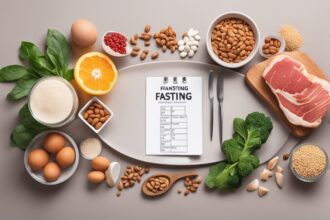Hey there, fellow health enthusiasts! If you’re diving into the world of fasting, you’ve probably wondered how to balance protein intake without breaking your fast or sabotaging your goals. Fasting isn’t just about skipping meals—it’s a powerful tool for improving metabolic health, boosting mental clarity, and even supporting longevity. But protein, the building block of muscle and recovery, often becomes a point of confusion. Should you prioritize it? When should you eat it? How much is too much during a fasting window? In this comprehensive guide, we’ll explore the intersection of fasting and protein, offering practical fasting tips grounded in science to help you optimize your health journey. Let’s unpack this together with actionable advice and insights to keep you thriving.
What Is Fasting, and Why Does Protein Matter?
Fasting, at its core, is the practice of abstaining from food for a specific period. Whether you’re trying intermittent fasting (like the 16:8 method) or extended fasts, the goal often revolves around giving your body a break from digestion, promoting autophagy (cellular cleanup), and improving insulin sensitivity (Mattson et al., 2017). But here’s where protein enters the chat: it’s essential for maintaining muscle mass, repairing tissues, and supporting overall bodily functions. During fasting, your body might turn to stored protein (via muscle breakdown) for energy if not managed properly, which could lead to muscle loss—a big concern for anyone active or aiming for a lean physique. Understanding how to integrate protein with fasting tips is key to reaping the benefits without the downsides.
How Fasting Impacts Protein Metabolism
When you fast, your body shifts gears. Without incoming calories, it taps into stored energy—first glycogen, then fat, and, if prolonged, protein from muscle tissue through a process called gluconeogenesis (Longo & Mattson, 2014). This is why extended fasting without preparation can be risky for muscle health. However, short-term fasting, like intermittent fasting, often preserves muscle mass better, especially if you’re strategic about protein intake during eating windows. Studies suggest that resistance training combined with adequate protein post-fast can minimize muscle breakdown and even stimulate growth (Morton et al., 2018). So, one of the best fasting tips is timing your protein intake to align with your body’s needs—more on that soon.
Timing Protein Intake Around Your Fasting Window
One of the most common questions I hear is, “When should I eat protein while fasting?” The answer lies in your eating window. If you’re following a 16:8 intermittent fasting plan, you’ve got 8 hours to fuel up. Breaking your fast with a protein-rich meal can kickstart muscle protein synthesis—a fancy term for muscle repair and growth (Tipton & Wolfe, 2001). Aim to consume 20–30 grams of high-quality protein (think eggs, chicken, or a whey shake) within the first hour of your eating window. This not only curbs hunger but also signals your body to rebuild rather than break down. For those doing longer fasts, like 24–48 hours, consider a gradual refeed with smaller, protein-focused meals to avoid digestive overwhelm. Timing is a game-changer among fasting strategies for maintaining muscle.
How Much Protein Do You Need While Fasting?
Protein needs vary based on your activity level, age, and goals, but fasting doesn’t mean you should skimp. The Recommended Dietary Allowance (RDA) for protein is 0.8 grams per kilogram of body weight, but active individuals or those fasting may need 1.2–2.0 grams per kilogram to preserve muscle (Wu, 2016). If you’re a 70 kg (154 lb) person, that’s roughly 84–140 grams daily during your eating window. Overdoing protein, though, can spike insulin and potentially disrupt the benefits of fasting, like ketosis. A practical fasting tip is to split your protein across meals in your eating window—say, 30–40 grams per meal if you eat three times. This keeps your body fueled without overloading your system.
Best Protein Sources for Fasting Practitioners
Not all protein is created equal, especially when you’re fasting. You want sources that are nutrient-dense, easy to digest, and won’t weigh you down after hours of not eating. Here are some top picks to incorporate into your fasting routine:
- Lean Meats: Chicken breast, turkey, and lean beef provide high protein with minimal fat, ideal for breaking a fast without digestive stress.
- Eggs: A complete protein with all essential amino acids, eggs are versatile and gentle on the stomach post-fast.
- Plant-Based Options: Lentils, tofu, and tempeh work well for vegetarians, offering protein plus fiber to keep you full.
- Whey Protein: A quick-digesting option for post-fast recovery, especially if you’re training—mix with water to avoid extra calories.
- Fish: Salmon or cod deliver protein and omega-3s, supporting overall health during fasting protocols.
Common Pitfalls to Avoid with Fasting and Protein
While fasting can be transformative, pairing it with protein intake comes with some pitfalls. Let’s break down a few mistakes to steer clear of, ensuring your fasting success isn’t derailed:
- Overeating Protein Post-Fast: Loading up on too much protein at once can spike insulin and negate fasting benefits—stick to moderate portions.
- Ignoring Hydration: Fasting dehydrates you, and protein metabolism needs water—drink plenty during and after your fast.
- Skipping Strength Training: Without resistance exercise, your body may not prioritize muscle preservation, even with protein (Morton et al., 2018).
- Choosing Low-Quality Sources: Processed meats or sugary protein bars can inflame your system—opt for whole, clean options.
Balancing Fasting Benefits with Muscle Preservation
fasting tips for muscle preservation is to break your fast with a protein shake and hit the gym within an hour—your muscles will thank you.
Let’s wrap this up with a heartfelt reminder: Fasting is a personal journey, and there’s no one-size-fits-all approach. Whether you’re fasting for weight loss, mental clarity, or spiritual reasons, protein plays a starring role in keeping your body strong and resilient. By timing your intake, choosing quality sources, and avoiding common mistakes, you can master the art of fasting without sacrificing health or muscle. Experiment with these fasting tips, listen to your body, and adjust as needed. Got questions or personal experiences to share? Drop them in the comments—I’d love to hear how you’re balancing fasting and protein in your life. Here’s to health, strength, and sustainable habits!
References
- Cell Metabolism, 19(2), 181–192. https://doi.org/10.1016/j.cmet.2013.12.008
- Mattson, M. P., Longo, V. D., & Harvie, M. (2017). Impact of intermittent fasting on health and disease processes. Ageing Research Reviews, 39, 46–58. https://doi.org/10.1016/j.arr.2016.10.005
- Morton, R. W., Murphy, K. T., McKellar, S. R., Schoenfeld, B. J., Henselmans, M., Helms, E., … & Phillips, S. M. (2018). A systematic review, meta-analysis and meta-regression of the effect of protein supplementation on resistance training-induced gains in muscle mass and strength in healthy adults. British Journal of Sports Medicine, 52(6), 376–384. https://doi.org/10.1136/bjsports-2017-097608
- Tipton, K. D., & Wolfe, R. R. (2001). Exercise, protein metabolism, and muscle growth. International Journal of Sport Nutrition and Exercise Metabolism, 11(1), 109–132. https://doi.org/10.1123/ijsnem.11.1.109
- Trexler, E. T., Smith-Ryan, A. E., & Norton, L. E. (2014). Metabolic adaptation to weight loss: Implications for the athlete. Journal of the International Society of Sports Nutrition, 11(1), 7. https://doi.org/10.1186/1550-2783-11-7
- Wu, G. (2016). Dietary protein intake and human health. Food & Function, 7(3), 1251–1265. https://doi.org/10.1039/C5FO01530H






